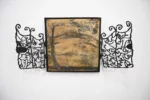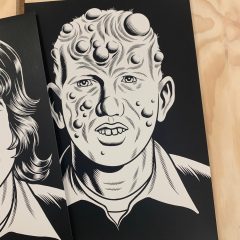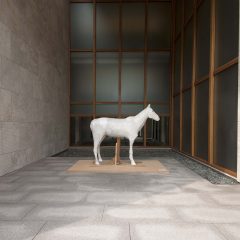
Howard Finster
Drawing for PC, 1981
colored pencil and ink on paper
A marvel of a drawing Howard Finster made for Philadelphia College of Art (now University of the Arts) graces the entrance of the exhibit Drawing in the World at the Rosenwald-Wolf Gallery at UArts. The drawing made in 1981 for an outsider art exhibit in the same gallery — organized by Elsa Weiner (Elsa Longhauser) — stopped us in our tracks. Our eyes traced the banners of names of artists animating the surface; we admired the way Finster used Martin Ramirez-like arcs of lines to define and fill space; we pondered the past and the present all represented in this drawing–Philadelphia art history, outsider art history, and the school’s history and Rosenwald-Wolf Gallery’s history. (RWG, now run by Sid Sachs, who stepped us through the show, mentioned the gallery’s impressive list of directors including Longhauser, Paula Marincola, Janet Kardon, Leah Douglas and Gerard Brown!)
Here’s what we say about the Finster: Keep this iconic piece out of storage already… and make it into a poster or something! We at artblog declare it a treasure–a signature piece of the school’s and the gallery’s identity.
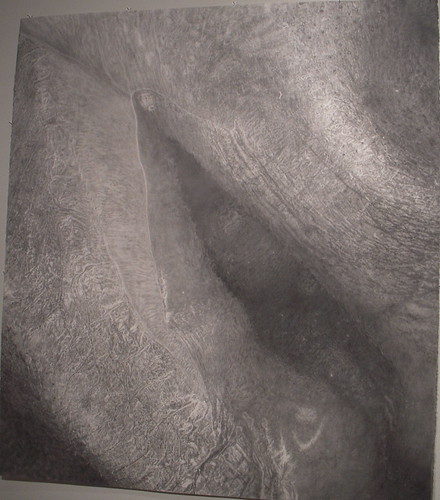
The rest of the show lived up to the Finster! It’s a far-reaching exhibit, showing a wide variety of contemporary and traditional approaches to drawing, and it is filled with outstanding work, even though it grew out of a humble mission to support the drawing curriculum. (See the results of the school’s recent drawingathon in the Hamilton Foyer gallery across the street from RWG.)
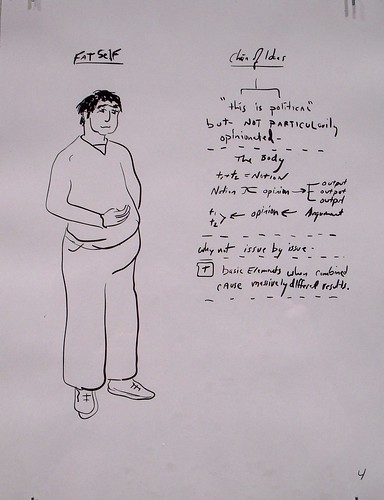
Pencil or pen never touch paper in Josh Mosley’s totally cyber-made drawings
Plus so much of the work in this show is related to work now showing at the ICA and Fleisher/Ollman–all serendipitous concordance. Sachs said he didn’t know about this show’s harmonic convergence with Anthony Campuzano‘s and Josh Mosley‘s solo exhibits at the ICA right now.
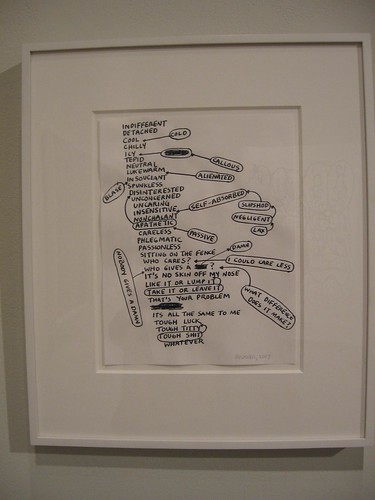
Mel Bochner, Indifferent 2007, ink on paper
He was surprised when he saw that Campuzano, Mel Bochner, and Isaac Resnikoff are also currently in the Rich Text exhibit at Fleisher/Ollman.
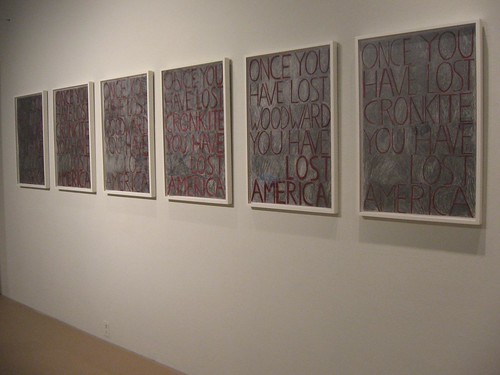
Anthony Campuzano, Vietnam/Iraq, Cronkite/Woodward, 2007
colored pencil and graphite on illustration board
Crazy! But it all works great for the artists — a trifecta for Campuzano and double whammy for the others.
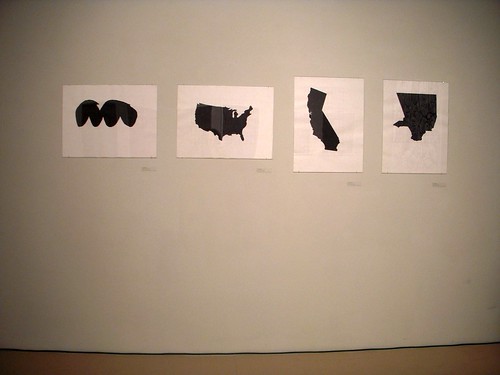
Isaac Resnikoff, Local News (world, country, state, county). chalkboard paint on paper. courtesy Fleisher/Ollman Gallery
Here’s some more of what we saw:
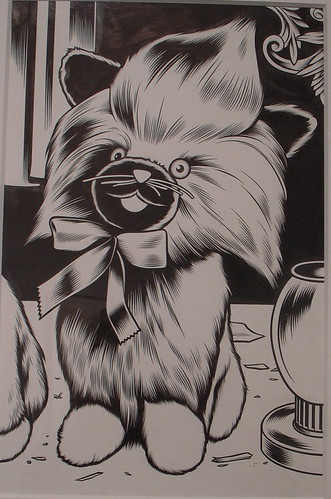
Charles Burns
From Black Hole
ink on paper
It seems like no show of contemporary drawing can happen without a salute to cartoons and comics. This show includes on of Philadelphia artist Charles Burns‘ Black Hole drawings. Word is that the movie based on the book may be in its very own Black Hole, where orphan movies often get swallowed up, but we hold out hope for it here on artblog.
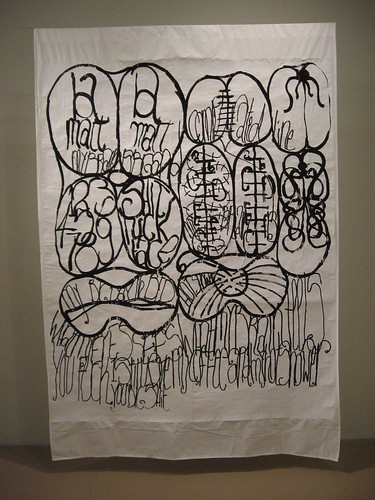
Matt Mullican, untitled (Learning from APerson’s Work), 2008, ink paper collage on bedsheet
Matt Mullican‘s totemic bedsheet, covered with text that defies easy decoding, including lots of swear words and numbers, was made– we think this is right — under hypnosis. Several videos next to it show the artist working under hypnosis, crawling around the floor and at one point shouting. Sachs says he doesn’t know whether the process-driven artist is really in a hypnotic state or not. Either way, the idea is wacky and the bedsheet piece is nicely weird.
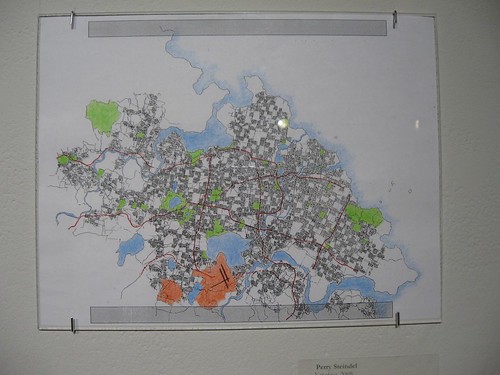
Perry Steindel, Yapahiya, 2008
ink colored pencil on xerox, courtesy the artist
“Maps” created from the heads of Perry Steindel and Andrew Herman are not all the two artists have in common.
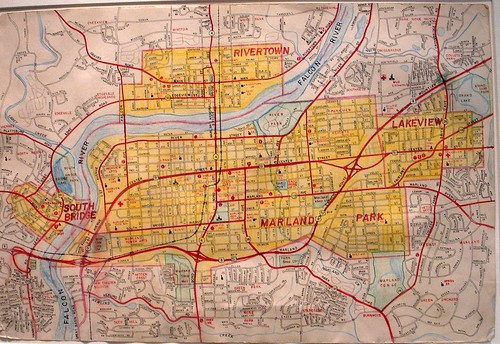
Andrew Herman
Marland Park, 1982
ink, marker, colored pencil and whiteout on paper
courtesy Fleisher-Ollman Gallery
Both of them have number-cruncher day jobs, according to Sachs. On seeing one of Herman’s maps of an imaginary place, Steindel said Herman put the roads in the wrong place!!!

Joseph Grigely, Thirteen untitled conversations, 2004
ink and pencil on paper, collection of Glenn Fuhrman, NY, Courtesy the FLAG Art Foundation
Sachs told us the notes in Joseph’s Grigely‘s pieces were from written conversations in restaurants. Grigely is deaf. The placement of the notes is not random. The artist sent a template for what goes where to line them all up precisely.
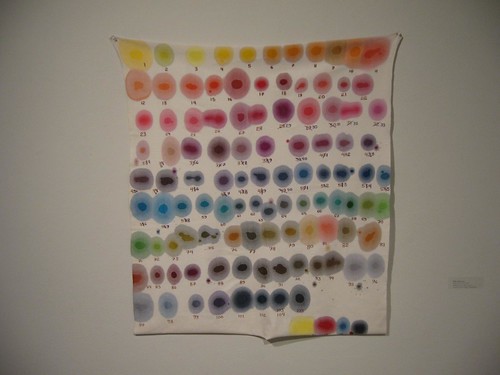
Polly Apfelbaum, Blossom Color Chart, 2000
textile dye on synthetic velvet, courtesy Locks Gallery
Polly Apfelbaum‘s Blossom Color Chart, which lights up its corner of the room, declares fabric and color and sytematization are proper spheres for drawing.
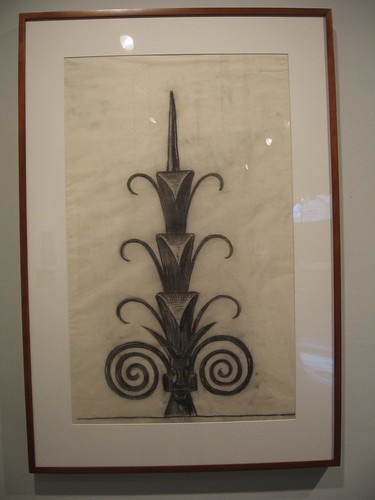
Samuel Yellin, Cresting Detail, ca. 1928
There’s a bunch of archival work in this show–many of them surprises. A plan for a fence finial by renowned wrought iron designer Samuel Yellin, a Philadelphian whose work graces so many Philadelphia and New Orleans buildings, is one of several architecture-related pieces borrowed from the University of Pennsylvania’s Architectural Archives.
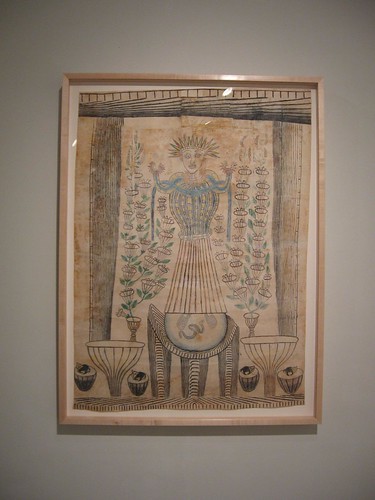
Martin Ramirez, Untitled (Madonna) 1950-3
wax crayon
The show includes a 1931 study by Russian cinema master, Sergei Eisenstein, for his movie Que viva Mexico; two Henry Moore drawings (from the Penn Architecture Archive) and a Martin Ramirez–one of the artists included in the 1981 show marked by Finster’s piece.

Lee Bontecou
Untitled #12, 1975
graphite and red pencil on gessoed paper
Another surprising but great inclusion is a drawing by Lee Bontecou, beautiful with sea and sky references (or desert and hallucination references, who knows). It’s the second-sexiest picture in the show. Let’s hear it for the ladies!!!–who by the way are well respresented here. There is also work by Jina Valentine, Judy Pfaff, Ellen Phelan and Jennifer Bartlett as well. Speaking of the distaff, on our way out we noticed preparatory printouts on the office wall for Sachs’ Women of Pop exhibit (coming up next year). Can’t wait for that show.
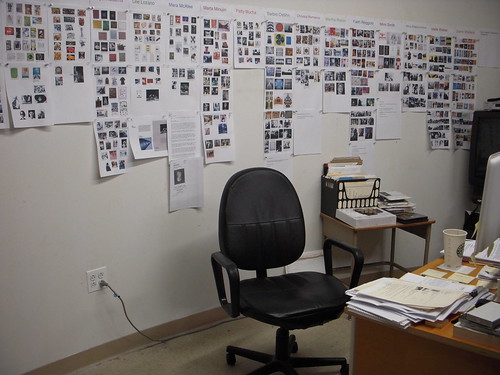
Women of Pop, working printouts above RWG gallerist Ed Waisnis’ desk in the gallery office.
And, and…we ran into Alex Gartelmann (of My House Gallery and, now, Little Berlin). He works at Uarts and he told us to check out his Window on Broad installation, which we dutifully did. The lumberjack love and heraldry (two axes raised; heart-shaped hole in tree trunk) is so extreme it’s endearing. Happy Retirement, says the verbiage. Who’s got time to retire we want to know.
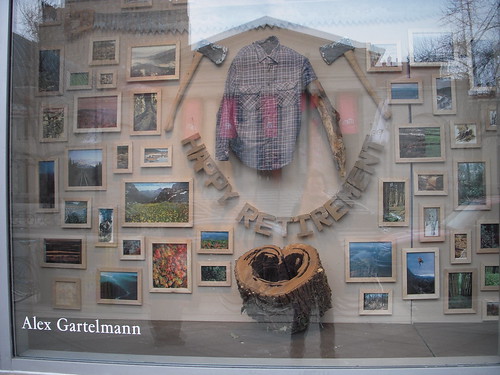
Alex Gartelmann, Window on Broad
Drawing in the World is up to Feb. 22. Get on over cowboys and cowgirls.


